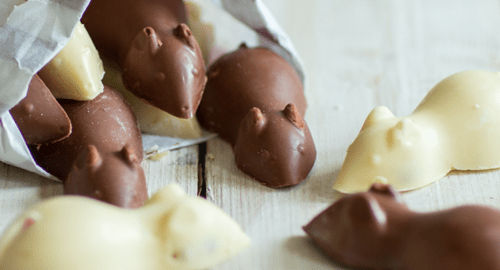Move over cheese, there’s a new love interest in town for mice – chocolate. Yes, you read that right! These tiny creatures with a penchant for mischief have developed an undeniable attraction to the sweet treat that seduces humans worldwide. But what makes chocolate so irresistible to mice? Let’s delve into this sweet love affair and uncover the reasons behind their infatuation.
First and foremost, mice are naturally drawn to high-calorie foods as they provide the energy they need to scurry around their habitats. And chocolate, with its rich and decadent taste, certainly fits the bill. Furthermore, studies have shown that the aroma of chocolate has a euphoric effect on mice, triggering dopamine release in their brains – the same pleasure-inducing chemical that humans experience.
But it’s not just the taste and aroma that captivate these little rodents. Chocolate also contains theobromine, a compound that acts as a stimulant and can produce a mild euphoria in mice. This compound, found in higher concentrations in dark chocolate, can have a similar effect on mice as caffeine does on humans, providing them with a burst of energy and alertness.
So the next time you find a chocolate bar mysteriously nibbled on, don’t blame the kids or your partner – it might just be the work of a lovestruck mouse on a quest for a sugar rush!
The science behind mice’s attraction to chocolate
Mice are known for their curious nature, constantly seeking out food sources that provide the energy they need to thrive. This quest for sustenance often leads them to high-calorie options, and chocolate stands out as a prime candidate. The energy-dense composition of chocolate, filled with sugars and fats, makes it an appealing choice for these little foragers. In the wild, the energy from such foods is crucial for survival, particularly when food is scarce. Thus, it’s not surprising that chocolate, with its decadent flavor and caloric richness, has captured the attention of mice.
Furthermore, the biochemical makeup of chocolate plays a significant role in attracting mice. High levels of sugar in chocolate create an immediate urge for consumption. Mice possess a keen sense of taste, particularly for sweet flavors, which are often associated with energy-rich foods in nature. When they encounter chocolate, the sweet flavor acts like a beacon, drawing them in. This evolutionary trait ensures that they gravitate towards nutrient-rich foods that are essential for their well-being and reproductive success, reinforcing their attraction to chocolate.
Additionally, research has indicated that the scent of chocolate can evoke a powerful response in mice. The olfactory senses of these rodents are highly developed, allowing them to detect and enjoy the aroma of various foods, including chocolate. When the sweet scent wafts through the air, it can trigger a strong desire to explore and consume the source of that tantalizing smell. This combination of taste and aroma creates an irresistible allure, making chocolate a prime target for these little critters.
The role of taste and smell in mice’s love for chocolate
Taste and smell are integral components of how mice perceive and interact with their environment. Mice rely heavily on their senses to identify food sources that will sustain them. The unique flavor profile of chocolate, characterized by its sweetness and richness, is particularly appealing to mice. Their taste buds are attuned to detect sugars, prompting an immediate response when they encounter chocolate. This aversion to bitter tastes, coupled with their preference for sweetness, means that chocolate is almost like an irresistible treasure trove for them.
Moreover, the aromatic compounds found in chocolate play a pivotal role in attracting mice. The complex bouquet of scents released by chocolate can trigger powerful instincts. The combination of sweet and rich aromas signals the presence of a high-energy food source, prompting them to seek it out. This olfactory intrigue is further amplified by the fact that mice have a remarkable ability to discern different scents, allowing them to locate chocolate even from a distance. When they catch a whiff of chocolate, it signals a potential feast, and their instincts kick in, leading them to investigate the source further.
The interplay between taste and smell is not just a simple preference; it’s a survival mechanism. The sweet taste of chocolate, combined with its alluring aroma, reinforces its desirability. This sensory combination creates a powerful urge to consume chocolate, which in turn contributes to the ongoing fascination that mice have with this indulgent treat. The sweet flavor compensates for the energy expended in searching for food, making chocolate a highly efficient choice for these energetic little foragers.
The impact of chocolate on mice’s brain and behavior
The relationship between chocolate and the brain of a mouse is a fascinating subject of study. Chocolate contains several compounds, one of the most notable being theobromine. This stimulant has a similar effect on mice as caffeine does on humans. When consumed, theobromine can enhance alertness and energy levels, triggering a dopamine release in the brain. Dopamine is often referred to as the “feel-good” neurotransmitter, and its release results in a pleasurable sensation. This euphoric effect further solidifies chocolate’s status as an irresistible treat for mice.
Moreover, the consumption of chocolate can lead to changes in behavior. As mice indulge in chocolate, their activity levels may increase due to the stimulating effects of theobromine. This can manifest as increased exploration and heightened curiosity, making them more adventurous in their foraging behavior. The energy boost provided by chocolate allows them to engage more actively with their surroundings, which is essential for their survival in the wild. This stimulating effect can be seen as a double-edged sword; while chocolate provides energy and pleasure, it also encourages behaviors that may put them at risk if they venture too far from safety.
Notably, the effects of chocolate on the brain may also have longer-term implications. Consistent exposure to chocolate can lead to a form of behavioral conditioning where mice begin to associate the sweet treat with positive experiences. This association can enhance their foraging strategies, making them more adept at locating and consuming high-calorie foods in the future. Thus, the impact of chocolate on mice goes beyond mere attraction; it influences their behavior, making them more resourceful and energetic in their quest for sustenance.
Historical evidence of mice’s affinity for chocolate
The relationship between mice and chocolate is not a new phenomenon; it has been observed throughout history. Evidence suggests that chocolate has been a part of mice’s diets for centuries, particularly in human habitats. As chocolate became a staple in human cuisine, it inadvertently became a food source for mice. Historical records indicate that chocolate was consumed in various forms, from solid bars to liquid concoctions, which would have attracted mice looking for easy meals left behind by humans.
In ancient civilizations, where food was often scarce, mice would have been drawn to any high-calorie sustenance available. The introduction of chocolate to Europe in the 16th century marked a significant increase in its availability, leading to a greater likelihood of mice encountering it. With the establishment of chocolate factories in the 19th century, the production of chocolate became widespread, creating a new environment for mice to thrive. Reports from urban areas reveal that where there is an abundance of chocolate, there is also a notable presence of mice, highlighting their enduring attraction to this delectable treat.
Additionally, the observations of farmers and households throughout history have provided anecdotal evidence of mice’s love for chocolate. Tales of mice raiding pantries or nibbling on forgotten chocolate bars have been common. These stories underscore the timeless bond between mice and chocolate, one that continues to be relevant today. As long as chocolate remains a beloved treat for humans, it is likely that mice will continue to seek it out, perpetuating their long-standing affinity for this sweet indulgence.
The potential health risks for mice consuming chocolate
While chocolate may be an enticing treat for mice, it is important to recognize the potential health risks associated with its consumption. The primary concern stems from theobromine, which can be toxic to small animals, including mice. The amount of theobromine present in chocolate varies depending on the type; dark chocolate contains significantly higher concentrations compared to milk chocolate. Even small amounts of chocolate can lead to adverse effects, including increased heart rate, restlessness, and gastrointestinal distress in mice.
Furthermore, the high sugar content in chocolate can pose additional health threats. Mice, like humans, can suffer from obesity and related health issues when consuming excessive amounts of sugar. A diet high in sugar can lead to metabolic disorders, impacting their overall health and lifespan. As mice indulge in chocolate, they may inadvertently compromise their well-being, as the immediate pleasure derived from the treat could lead to long-term health consequences.
Lastly, the consumption of chocolate may disrupt the natural dietary habits of mice. In the wild, mice typically thrive on a balanced diet consisting of grains, seeds, and vegetation. When they develop a penchant for chocolate, they may opt for this high-calorie treat over their traditional food sources. This shift can lead to nutritional imbalances, further exacerbating health risks. Hence, while the allure of chocolate is undeniable, it is essential to be mindful of the potential dangers it poses to these little creatures.





